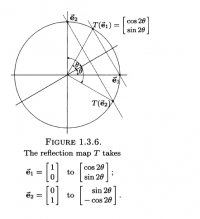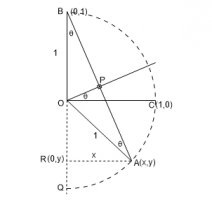Hello,
for the figure below I try to justify the reflection mapping. They say that [imath]e_1 -> T(e_1)[/imath] is described by a mapping [math]\begin{bmatrix} cos(2\theta)\\ sin(2\theta) \end{bmatrix}[/math]. I can get to the same result by drawing a parpendicular from [imath]T(e_1)[/imath] to the X axis and then write simple trigonometry formula for cosine [math]\frac{x}{r} = cos(2\theta) -> x = rcos(2\theta)[/math] where 'r' is the length of the vector (here r = 1 since [imath]e_1[/imath] is a basis vector). Similarly for the sine function I get the expected transformation. However I can't get the tranformation for [imath]e_2[/imath]. Since the angle is obtuse I was thinking about first writing the transformation of e2 on the X axis and lateer from X to T(e2). But since we don't know the angles I have no idea how to do this.

Thanks!
for the figure below I try to justify the reflection mapping. They say that [imath]e_1 -> T(e_1)[/imath] is described by a mapping [math]\begin{bmatrix} cos(2\theta)\\ sin(2\theta) \end{bmatrix}[/math]. I can get to the same result by drawing a parpendicular from [imath]T(e_1)[/imath] to the X axis and then write simple trigonometry formula for cosine [math]\frac{x}{r} = cos(2\theta) -> x = rcos(2\theta)[/math] where 'r' is the length of the vector (here r = 1 since [imath]e_1[/imath] is a basis vector). Similarly for the sine function I get the expected transformation. However I can't get the tranformation for [imath]e_2[/imath]. Since the angle is obtuse I was thinking about first writing the transformation of e2 on the X axis and lateer from X to T(e2). But since we don't know the angles I have no idea how to do this.

Thanks!

